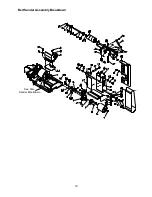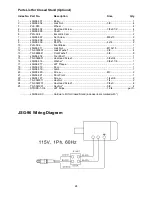
13
4. If the miter slot is not parallel, loosen the two
socket head cap screws (A, Fig. 13) and
adjust for parallel. Tighten the two screws
when the adjustment is complete.
5. Always maintain a gap of approximately 1/16”
between the table edge and disc. Once the
table is square and parallel to the disc adjust
the 90° stop. Loosen hex nut (B, Fig. 13) and
tighten the set screw (C, Fig. 13) until it
contacts the trunnion. Tighten hex nut.
6. If the pointer does not line up with the “0” on
the scale loosen the screw and adjust for “0”.
Tighten the screw.
7. The table can be tilted between 0°-45° by
loosening the handle (D, Fig. 13) and tilting the
table to the desired angle. Tighten the handle.
Always maintain a gap of approximately 1/16”
between the table edge and disc.
Note:
The belt table can be removed and the
disc table can be used in its place. There are
two holes in the base below the sanding belt
that will accommodate the disc table’s support
rod and locking handle.
Sanding Disc Replacement
1. Disconnect machine from the power source.
2. Loosen the handle (C, Fig. 14) and remove the
table assembly (A, Fig. 14).
3. Turn the knob (B, Fig. 14) and swing open the
cover.
4. Remove old sanding disc by stripping from
wheel. Make sure the disc plate is clean.
5. Press the new disc firmly into place.
Center Point
The center point (A, Fig. 15) provided with the
sander can be used for sanding circles. The center
point can be locked in position by tightening the set
screws (B, Fig. 15).
On/Off Switch
The machine can be turned on by moving the
switch (C, Fig. 15) to the up position. The key (D,
Fig. 15) can be removed when the machine is in
the off position. With the key removed the switch
will not operate.
Figure 13
Figure 14
Figure 15
Содержание 708595
Страница 16: ...16 Disc Sander Assembly Breakdown...
Страница 19: ...19 Belt Sander Assembly Breakdown See Disc Sander Breakdown...
Страница 23: ...23 Closed Stand Assembly Optional...










































